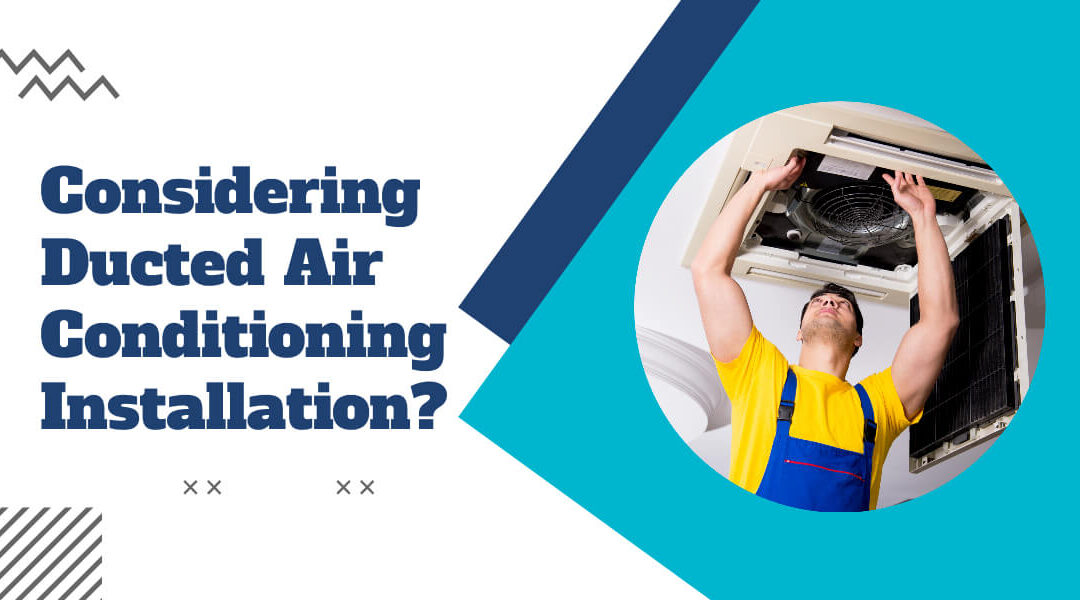In Australia, where the weather runs to extremes, it’s essential to have a reliable and powerful air conditioner installed. Whether you’re a homeowner in Brisbane or a business owner in Queensland, this holds true.
A comfortable climate and clean air improve staff and customer comfort, create a healthier working environment and help protect business-critical equipment from the effects of humidity and heat. Meanwhile, a quality air con not only helps ensure comfort but also adds to the value of your home.
If you’ve been thinking of having AC installed, you’ve probably come across ducted AC systems. The ducted AC system, also called a ducted reverse cycle air conditioner, is a popular choice for homes and businesses alike, but is it the right one for your needs?
Read on to learn more about this type of AC system as well as the factors you need to consider before proceeding with the installation of a ducted air unit.
What Is Ducted Air Conditioning?
Also called a central AC system, a ducted air conditioner has one central air handling unit, typically located outside the building. This type of air conditioner has an indoor fan coil unit and air mixing plenum placed within the roof cavity. Cooled air is then distributed from the condenser by the fan unit through a system of ducts and released through vents.
Ducted systems can effectively cool large spaces. This makes them ideal for offices, factories and other places of business. A professional installer may recommend you install ducted air conditioning if you have a large home.
Key Features of Ducted AC
Before you install a ducted air conditioning system, it’s best to learn more about its advantages and disadvantages. Installing a ducted air unit is a major investment, and doing your research now will help you prevent a costly mistake later.
Here are some of its advantages and features.
Temperature Control
You might choose a ducted air conditioning unit if you want more control over the temperature in individual zones without the need for multiple units. As mentioned previously, there is no need to install an individual indoor unit for all parts of your home or building.
The temperatures of areas of your home or building are controlled by a thermostat. For instance, you could keep your bedroom at a comfy 18.3 20°C and the living room at a slightly warmer 20°C. You can change the temperature either with an on/off switch or a controller. The latter lets you adjust the airflow and temperature according to your preferences.
Dehumidification
Some cooling and heating system manufacturers, like Daikin and Mitsubishi Electric, offer ducted AC models with advanced dehumidification features. The “dry mode” setting, found in many of their units, takes moist air back through the return air grille or return air box. The humid, warm air is then replaced with drier, chilled air.
Unobtrusive Appearance
In ducted air con, only one condenser unit is necessary for an entire house or facility, regardless of its size or layout. The central air handling unit is installed in your ceiling cavity.
There is no need for bulky cassettes or standing cooling or heating units that may impact your building’s interior design. The air ducts are also concealed, and only the vents are visible. You may want to consider ducted air conditioning installation if you want to preserve the look and feel of your interiors.
Noise Control
Unlike a wall or window unit, or even an older split system, a ducted system does not emit a constant, irritating drone. This is because most of the moving parts of a ducted air system are within the central air unit outside the property and the indoor fan coil in the space between the roof and the ceiling.
If quiet operations are a priority, be sure to look for a model with a sound rating of 50 dB to 60 dB. Additionally, be on the lookout for features that help you control HVAC noise levels. Some examples are:
- Noise blanket — Before you start the installation process, ask the installer if the model you’ve chosen has compressor insulation. Also referred to by professionals as a noise blanket, this feature encloses the compressor to reduce the noise from the outdoor unit.
- Noise-reducing fan blade design – There are AC units, from trusted manufacturers like Daikin and Fujitsu, that offer ducted air AC models with fan blades designed to make as little noise as possible.
Energy Efficient
Ducted systems are highly efficient, able to cool or warm large, multi-room spaces. A thermostat can ensure consistent or customized temperatures throughout the whole building, regardless of its size and layout.
Motion detection sensors, installed in ductwork, help with saving you money on energy bills. They detect when a person enters a room and automatically switch the system on to cool the area. If the sensors determine that there is no one in a zone, they reduce the chilled air flow to that area, allowing you to maximise energy efficiency.
Is a Ducted System Right for You? Factors to Consider
While a ducted AC has many advantages over other types of air conditioners, it’s not ideal for all situations. Before hiring a company to install ducted air conditioning in your home or business, consider these factors first:
Ducted Air Conditioning Cost
The cost of installing a ducted AC system installation depends on many factors. How much it costs could vary widely depending on the unit you choose, labor charges, and the materials needed, from drop sheets refrigeration pipes and the electrical systems connecting the indoor and outdoor units. Costs may also be higher or lower, depending on the size of the building.
Generally, however, ducted AC is more expensive than window and split-type systems. You can save on the overall cost of ducted air conditioning by choosing a provider that offers ducted air conditioning packages.
Roof Space and Structure
Ducted AC installation requires adequate roof space for the fan coil unit to have the ability to run properly. Additionally, the structure of your roof and the ceiling type dictate whether you can install a ducted AC system for your home or business. An HVAC professional can perform a detailed inspection of your roof as well as an inspection of your roof cavity so you can determine whether installing a new ducted air system is possible.
Maintenance
Once you have your system installed, you need to ensure it stays in excellent running condition so you can make the most of your investment. should be prepared for annual air conditioning service calls. Even the most high-quality air conditioning systems require maintenance and cleaning every 12 months to keep them in excellent running condition.
During a standard maintenance call, your AC service provider will perform a number of checks and fixes on:
- The tray drain and the condensate drain
- Refrigerant lines and electrical wires
- Filters
- System and evaporator coils
- Ductwork
- Zoning gates
- Mixing plenum on the indoor unit
- Safety tray drain
- And more
The Bottom Line
Ducted AC systems are a great choice for residential and commercial properties. They are powerful enough to ensure comfortable indoor temperatures even in large spaces, and they have numerous other advantages ranging from energy efficiency to quiet operations.
However, if you don’t want to deal with high upfront costs or don’t have a large space that needs cooling, then a split-type system or other types of AC might be a better option for you. A trusted HVAC&R professional can help you determine which option is best for your needs as well as answer any questions you may have about ducted units.
HP6 is a leading provider of residential, commercial and industrial HVAC&R solutions. Learn more about their services here.

